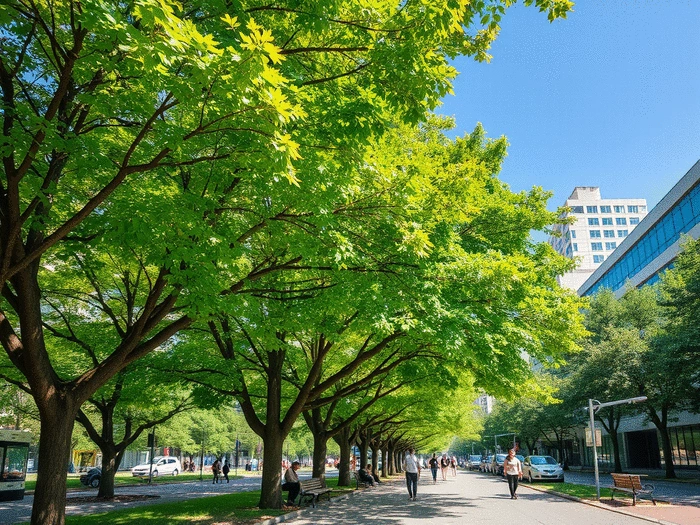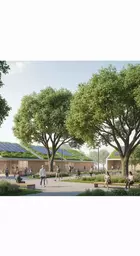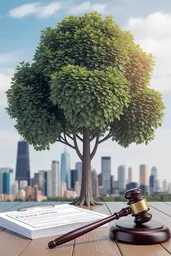Trees: Nature’s Urban Cooling Solution

Posted on: 2025-10-05
By: Keira Vallejo
Ever wondered how a simple tree can be a powerful ally in combating urban heat? Urban trees not only beautify our surroundings but also serve an essential purpose in cooling our cities and enhancing our quality of life. Understanding their role can inspire us to become advocates for greener urban spaces.
What You Will Learn
- Urban trees significantly mitigate the "urban heat island" effect, making cities cooler and more comfortable.
- Tree canopies provide shade, enhance air circulation, and lower surface temperatures through evapotranspiration, which can lead to reduced energy costs.
- Strategic tree planting in urban planning, such as placing deciduous trees on the south and west sides of buildings, can maximize cooling benefits.
- Integrating urban forestry into climate resilience planning helps combat extreme weather and promotes healthier urban ecosystems.
- Investing in green infrastructure, like parks and green roofs, can improve air quality, biodiversity, and community well-being.
- Well-placed trees can reduce air conditioning costs by up to 30%, making tree planting initiatives economically beneficial for communities.
Impact of Urban Trees on Energy Savings and Cooling
Strategically planting trees can significantly reduce cooling costs and improve energy efficiency. Below is a visual representation of how urban trees contribute to energy savings and cooling effects.
Cooling Cost Reduction
Trees can reduce cooling costs by up to 30%.
This translates to significant savings on air conditioning during hot months.
Energy Demand Calculation Steps
- Assess the shaded area.
- Calculate the cooling load of the building.
- Determine expected reduction in energy consumption.
Benefits of Urban Forestry
- Improved air quality
- Reduced stormwater runoff
- Lower neighborhood temperatures
Cost-Benefit Analysis Considerations
- Initial planting costs vs. long-term savings
- Maintenance expenses vs. air quality benefits
- Property value increases due to aesthetics
Understanding the Role of Urban Trees in Cooling
Have you ever felt a cool breeze under the shade of a tree on a hot summer day? Urban trees are not just pretty sights; they play a crucial role in cooling our cities! By understanding how they work, we can better appreciate their value in our urban landscapes and adopt practices that promote their growth and maintenance.
Research shows that cities can be significantly warmer than rural areas, a phenomenon known as the "urban heat island" effect. This is where urban trees come in, utilizing natural processes to help cool down their surroundings. In this article, we'll explore the science behind these cooling mechanisms and how we can leverage them for healthier urban spaces.
Scientific Basis for Natural Cooling Mechanisms
Let’s dive into the magical science behind how trees cool our environment. One of the main ways trees provide cooling is through their canopies. When sunlight hits a tree, it gets absorbed by the leaves, which then release moisture back into the air. This process can lower surrounding temperatures significantly!
Additionally, tree canopies can provide shade to buildings and roads, minimizing heat absorption. To put it simply, shaded areas are cooler areas! This is one reason why planting trees around homes and businesses is so important. Here are some ways that tree canopies contribute to temperature reduction:
- Shade that reduces heat on paved surfaces
- Creation of cooler microclimates
- Enhancement of air circulation
Temperature Reduction through Tree Canopies
Imagine walking in a park on a sunny day, and the temperature dropping a few degrees as you step under a tree. That’s not just a feeling—it’s science at work! Tree canopies can reduce surface temperatures by blocking sunlight and cooling the air through evapotranspiration.
This natural cooling effect can lead to lower energy costs for air conditioning, especially during those scorching summer months. It’s a win-win! Not only do trees cool our environment, they also save us money, making their care and maintenance vital for urban communities.
Evapotranspiration: The Cooling Process Explained
So, what exactly is evapotranspiration? It’s a fancy term for the process where trees release water vapor from their leaves into the atmosphere. This process not only cools the air but also adds humidity, which can enhance our overall comfort levels.
As trees transpire, they create a cooler, moist environment that can help mitigate heat waves. It’s like giving your neighborhood its own air conditioning system! Understanding this process helps us appreciate the importance of maintaining healthy tree populations in our cities.
Examining Urban Heat Islands and Mitigation Strategies
The urban heat island effect is a pressing issue in many cities, where the concentration of buildings, roads, and other infrastructure can lead to higher temperatures. This phenomenon can negatively impact public health and increase energy demands.
Fortunately, trees can help combat these heat islands! By integrating trees into urban planning, we can create greener, cooler neighborhoods. Here are some key strategies for mitigating heat islands:
- Planting trees in high-traffic areas
- Creating green roofs and walls
- Incorporating parks and green spaces into urban designs
Defining Urban Heat Islands and Their Impact
Urban heat islands are areas within cities that experience higher temperatures than their rural surroundings. This phenomenon can lead to health risks such as heat exhaustion and respiratory issues, particularly for vulnerable populations.
By recognizing the significance of urban heat islands, we can start to implement effective strategies to combat their effects. Trees are like nature’s air conditioners, providing not only shade but also a buffer against the heat. Isn’t it amazing how much they contribute to our well-being?
How Trees Contribute to Urban Heat Mitigation
Trees contribute to urban heat mitigation by providing shade and lowering surface temperatures. By strategically planting trees in urban areas, we can make a significant difference. They also improve air quality, making our cities healthier.
Incorporating trees into our urban landscapes can lead to cooler, more inviting spaces for everyone. As I walk through my neighborhood, I always notice the difference when trees line the streets, creating a welcoming environment for families, friends, and nature lovers alike. Let's embrace the role of trees and continue nurturing our urban canopies!
The Role of Urban Forestry in Climate Adaptation
Urban forestry is about more than just planting trees; it’s about creating resilient communities that can adapt to a changing climate. By integrating urban forestry into climate resilience planning, we can protect our cities from extreme weather events and improve overall quality of life.
As a community, we can work together to understand the vital role trees play in our urban ecosystems. This knowledge empowers us to take action and support initiatives that promote sustainable urban forestry practices.
Integrating Urban Forestry into Climate Resilience Planning
Integrating urban forestry into climate resilience planning is crucial for enhancing urban environments. Trees improve air quality, reduce stormwater runoff, and provide habitats for urban wildlife. Furthermore, they can significantly lower neighborhood temperatures, making them essential allies in our fight against climate change.
By planning for urban forestry in our communities, we can create a greener, healthier, and more resilient future. Let’s invest in our trees so they can continue to thrive and support us for years to come!
Green Infrastructure and Its Benefits for Urban Cooling
Green infrastructure includes various natural systems, such as parks, green roofs, and street trees, that help manage stormwater and reduce urban heat. These elements work together to create cooler, more sustainable cities. By incorporating green infrastructure into urban design, we can enjoy numerous benefits:
- Improved air and water quality
- Reduced heat retention
- Enhanced biodiversity
In my work at Urban Canopy Blog, I’ve seen how embracing green infrastructure not only beautifies our cities but also fosters a sense of community. By working together to implement these initiatives, we can create a thriving environment for ourselves and future generations!
Quick Summary
Here’s a brief recap of the key points discussed so far:
- Urban trees mitigate the urban heat island effect by providing shade and enhancing air circulation.
- Evapotranspiration is a crucial process through which trees cool their surroundings and increase humidity.
- Strategic tree planting can lead to significant energy savings, reducing air conditioning costs by up to 30%.
Maximizing Energy Efficiency through Strategic Tree Planting
When it comes to enhancing energy efficiency in our urban neighborhoods, strategic tree planting is a game-changer! At Urban Canopy Blog, I believe that trees can do so much more than beautify our surroundings—they can significantly lower energy costs, particularly during those hot summer months. By understanding how to position trees effectively, we can create a cooler, more comfortable environment for everyone.
One of the best ways to get started is by focusing on the placement of trees around buildings. This involves considering factors like sunlight exposure, building height, and the surrounding landscape. When trees are planted where they can provide ample shade, we can reduce the need for air conditioning, leading to lower energy bills.
Practical Approaches to Tree Planting in Urban Environments
To achieve optimal cooling benefits, here are some essential guidelines for tree placement:
- **Plant deciduous trees** on the south and west sides of buildings to block the sun’s rays in summer.
- **Position evergreen trees** on the north side to act as windbreaks, reducing heating costs in winter.
- **Avoid crowding trees** too close to buildings, as this can cause excessive shade and compete for nutrients.
Choosing the right tree species is equally important! Some species are more effective at cooling than others, so consider trees with broad canopies and dense foliage. For instance, *maples* and *oaks* make fantastic choices for urban areas, as they provide excellent shade while also improving air quality.
Choosing the Right Tree Species for Effective Cooling
When selecting trees, think about the specific climate and soil conditions in your area. Here’s a simple checklist to keep in mind:
- **Drought resistance:** Opt for species that can thrive with minimal water.
- **Growth rate:** Look for fast-growing trees for quicker shade and cooling.
- **Pest resistance:** Choose trees that are less susceptible to pests and diseases.
By following these guidelines, you ensure that every tree you plant contributes to a cooler, greener urban landscape. Remember, it’s not just about aesthetics; it’s about creating a sustainable environment for generations to come!
Quantifying Energy Savings from Tree Planting
Now, let’s dive into the numbers! Planting trees can lead to significant energy savings, particularly when it comes to air conditioning demands. Research shows that well-placed trees can reduce cooling costs by as much as 30%. That’s a huge incentive for communities to consider tree planting initiatives more seriously.
To quantify energy savings, it’s important to measure how much shade your trees provide and how that affects indoor temperatures. Here’s a straightforward approach to calculate potential savings:
- **Assess the square footage** of the area shaded by the trees.
- **Calculate the cooling load** of the building using energy modeling software.
- **Determine the expected reduction** in energy consumption based on tree coverage.
These calculations not only help you understand the impact of trees on energy efficiency but also aid in advocating for more green spaces in your community.
Considering all these benefits, you might be thinking about taking care of your own trees. If so, make sure you follow seasonal tips for seasonal urban tree care to ensure your urban forest thrives!
Cost-Benefit Analysis of Urban Forestry Initiatives
Conducting a cost-benefit analysis can provide clarity on the economic impact of urban forestry projects. Here are key factors to consider:
- **Initial planting costs** compared to long-term energy savings.
- **Maintenance expenses** versus benefits like improved air quality and stormwater management.
- **Potential increases in property values** due to enhanced aesthetics and reduced energy costs.
By laying out these factors clearly, advocates for urban trees can effectively communicate the long-term value of green investments to local governments and stakeholders. As we continue to promote tree planting, it’s vital to share these insights with our communities, highlighting the important role that trees play in energy efficiency and sustainability.
Recap of Key Points
Here is a quick recap of the important points discussed in the article:
- Urban trees play a vital role in cooling cities by providing shade and reducing temperatures through evapotranspiration.
- Tree canopies create cooler microclimates and enhance air circulation, which helps lower energy costs for air conditioning.
- Integrating trees into urban planning is essential for mitigating the urban heat island effect and improving public health.
- Strategic tree planting, especially deciduous trees on sunny sides and evergreens as windbreaks, can maximize energy efficiency.
- Choosing appropriate tree species is crucial for effective cooling; consider drought resistance, growth rate, and pest resistance.
- Quantifying energy savings from tree planting can guide community initiatives and highlight the long-term economic benefits of urban forestry.
- How do urban trees help in cooling cities? Urban trees help in cooling cities through shading and evapotranspiration. They provide shade, which directly reduces the amount of sunlight absorbed by buildings and pavements. Evapotranspiration is the process by which trees release water vapor into the air, cooling the surrounding environment.
- What is the urban heat island effect, and how do trees mitigate it? The urban heat island effect refers to the phenomenon where urban areas experience higher temperatures compared to their rural surroundings due to the concentration of buildings and pavements. Trees mitigate this effect by providing shade and cooling the air through evapotranspiration, thus lowering the overall temperature in urban areas.
- What are the energy-saving benefits of planting trees around buildings? Planting trees around buildings can lead to significant energy savings. Trees can reduce the need for air conditioning by providing shade and lowering the temperature of the surrounding air, which can lead to a reduction in cooling costs by up to 30%. Furthermore, planting evergreen trees on the north side of buildings can act as windbreaks, reducing heating costs in winter.
- How does evapotranspiration work, and why is it important for urban cooling? Evapotranspiration is the process by which trees release water vapor from their leaves into the atmosphere. This process cools the air and increases humidity, contributing to a more comfortable environment. It’s important for urban cooling because it acts as a natural air conditioning system, helping to mitigate heat waves and lower overall temperatures in cities.
- What factors should be considered when choosing tree species for urban planting? When choosing tree species for urban planting, several factors should be considered, including drought resistance, growth rate, pest resistance, and the tree's ability to provide shade and cooling. It is also important to consider the specific climate and soil conditions in your area to ensure that the selected species can thrive.
- How can strategic tree planting maximize energy efficiency? Strategic tree planting involves carefully positioning trees around buildings to maximize their cooling effects. This includes planting deciduous trees on the south and west sides of buildings to block sunlight in the summer and evergreen trees on the north side to act as windbreaks in the winter. Proper placement can significantly reduce energy consumption for both cooling and heating.
Have you ever wondered about the connection between urban trees and mental well-being? It's fascinating how these green spaces can positively impact our psychological health!
Additionally, tree canopies can provide shade to buildings and roads, minimizing heat absorption. To put it simply, shaded areas are cooler areas! This is one reason why planting trees around homes and businesses is so important. Here are some ways that tree canopies contribute to temperature reduction:
To ensure your trees stay healthy, consider the benefits of professional tree care. Proper maintenance can significantly extend the life and health of your trees, maximizing their cooling benefits.
 Have you ever stopped to think about how the trees lining your city streets do more than just beauti
Have you ever stopped to think about how the trees lining your city streets do more than just beauti
 In urban environments, trees are often the unsung heroes contributing to our well-being and the over
In urban environments, trees are often the unsung heroes contributing to our well-being and the over
 Urban trees are essential to our cities, yet they face numerous threats from pests and diseases. Did
Urban trees are essential to our cities, yet they face numerous threats from pests and diseases. Did